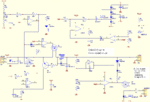mashal8050
Newbie level 6
Hi all !
I have a solar pannel in which
no. of cells =40
Volts per cell = 0.5V
Total V = 40 x 0.5 = 20V
As watts of per cell is 1.85W so
Total W = 40 x 1.85 = 75W Approx
I = 75/20 = 3A approximately.
I need to charge a battery of 12V and 5A, what Ah it will have !
therefore I need help regarding the battery charging control or a battery charger circuit !
i got the following circuit diagram but i am not able to understand it quite well ..
Any help would be highly appreciated
Regards

I have a solar pannel in which
no. of cells =40
Volts per cell = 0.5V
Total V = 40 x 0.5 = 20V
As watts of per cell is 1.85W so
Total W = 40 x 1.85 = 75W Approx
I = 75/20 = 3A approximately.
I need to charge a battery of 12V and 5A, what Ah it will have !
therefore I need help regarding the battery charging control or a battery charger circuit !
i got the following circuit diagram but i am not able to understand it quite well ..
Any help would be highly appreciated
Regards
